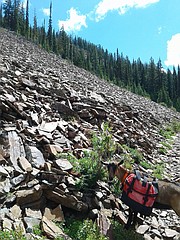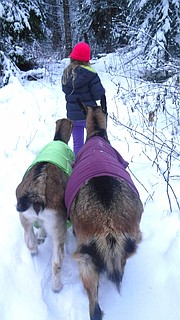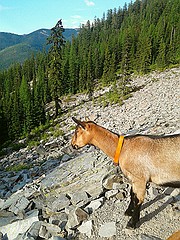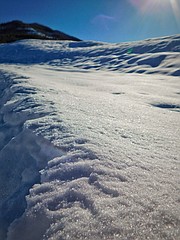Tank the Trail Finder: Keeping winter fun safe in a boom town!
It is no secret that Kellogg was once considered a “boom town.” It has a rich and prosperous mining history that earned it that title.
Over the last week though, the hills were alive with the sound of avalanche cannons, giving Kellogg and the surrounding areas a whole new definition of “boom town” that only mountain cities can claim.
I have to admit, every time I hear one of the echoing kabooms, it makes me grin. It is a reminder that we have received a big snowfall and our hills are blanketed with a thick new layer of fun to be enjoyed.
However, whether you backcountry ski, snowmobile, or snowshoe with goats, these booms should also serve as a reminder that avalanche danger is high.
It is an understatement to say that avalanches are dangerous, but they can be avoided, and staying home on the couch snuggling with your goat isn't the only way to do so.
With some precautions, and the ability to recognize the most likely slide areas, you can claim the slopes and conquer the fear.
First of all, remember the statistics.
• 95 percent of avalanches happen within the first 48 hours of a big storm, and this is caused by the added weight and weak bonds between the fresh and existing snow.
The probability of a slide is enhanced if the pre-existing snow had an icy or crystallized crust, or if the new layer of snow becomes heavy due to changing temperatures. Sometimes this first 48 hours can be a wise time to stay home, but if you are already out there, an easy way to determine if the temperatures are rising, is to be on the lookout for little natural snowballs rolling down the hills.
If you see these, it can be a sign of increased danger of a slide and you will want to consider your next set of statistics.
• 90 percent of avalanches happen on slopes that are between 30-45 degrees.
Now, unless you happen to have an inclinometer with you, this can be tricky to calculate, so my general rule of thumb is to try to avoid steep barren slopes especially if they are convex in shape, with either no trees or only new growth.
Also, it pays to be aware of signs that you may be on what I call an, “avalanche alley.”
Look for trees with broken branches on the uphill side, they are the “red flag” that a previous avalanche has claimed them as souvenirs.
If you see these signs, it is wise to bust a move for the mature trees, as they provide stability for snow, and increased safety.
If you must cross a slope steeper than 25 degrees, remember that it is safest to do so at the top or bottom.
I personally prefer the top, and if I can, get up on the ridge line.
The windward side provides thinner snow which is less likely to slide.
Try to stick as closely to the ridge line as possible and be careful not to get out on a concise (the wave shaped drift that forms on the lee side of ridge tops), as they can be unstable and the mere weight of a hiker can cause them to collapse.
If you do choose to cross a slope at the bottom, look uphill before proceeding.
If another party is crossing above you, let them go first, that way if they trigger a slide, you won't get caught up in the debris.
Although a lot of this knowledge may sound like common sense, I believe it bears repeating, because it is so easy to be blinded by passion and enthusiasm.
I don't want to inflict fear, but it pays to keep it in the back of your mind that each year avalanches claim the lives of skiers, snowmoblilers, and snowshoers alike.
All of us are out there to enjoy the natural beauty that only winter can provide, yet we are all susceptible to the dangers it holds as well.
Taking precautions and being wise to the surroundings may not make for an exciting story, but may keep you alive to adventure another day with your friends or “kids.”
• • •
As always, we love to hear from you, and welcome any comments or questions you may have. You can contact us via email at goattrekn@gmail.com, or follow our daily adventures by liking our Facebook page Goat Trek'n! Happy trails, and safe travels to you!









